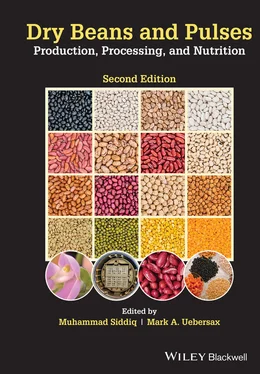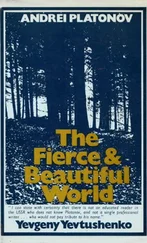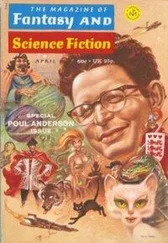Dry Beans and Pulses Production, Processing, and Nutrition
Здесь есть возможность читать онлайн «Dry Beans and Pulses Production, Processing, and Nutrition» — ознакомительный отрывок электронной книги совершенно бесплатно, а после прочтения отрывка купить полную версию. В некоторых случаях можно слушать аудио, скачать через торрент в формате fb2 и присутствует краткое содержание. Жанр: unrecognised, на английском языке. Описание произведения, (предисловие) а так же отзывы посетителей доступны на портале библиотеки ЛибКат.
- Название:Dry Beans and Pulses Production, Processing, and Nutrition
- Автор:
- Жанр:
- Год:неизвестен
- ISBN:нет данных
- Рейтинг книги:5 / 5. Голосов: 1
-
Избранное:Добавить в избранное
- Отзывы:
-
Ваша оценка:
- 100
- 1
- 2
- 3
- 4
- 5
Dry Beans and Pulses Production, Processing, and Nutrition: краткое содержание, описание и аннотация
Предлагаем к чтению аннотацию, описание, краткое содержание или предисловие (зависит от того, что написал сам автор книги «Dry Beans and Pulses Production, Processing, and Nutrition»). Если вы не нашли необходимую информацию о книге — напишите в комментариях, мы постараемся отыскать её.
The second edition of the most complete and authoritative reference on dry beans production, processing, and nutrition available Dry Beans and Pulses: Production, Processing, and Nutrition
Dry Beans and Pulses: Production, Processing, and Nutrition, Second Edition
Dry Beans and Pulses Production, Processing, and Nutrition — читать онлайн ознакомительный отрывок
Ниже представлен текст книги, разбитый по страницам. Система сохранения места последней прочитанной страницы, позволяет с удобством читать онлайн бесплатно книгу «Dry Beans and Pulses Production, Processing, and Nutrition», без необходимости каждый раз заново искать на чём Вы остановились. Поставьте закладку, и сможете в любой момент перейти на страницу, на которой закончили чтение.
Интервал:
Закладка:
REFERENCES
1 Adams, W. (1978). Dry Bean Production − Principles and Practices (pp. 151). Extension Bulletin E‐1251. East Lansing, MI: Michigan State University.
2 Aguilera, J.M., Lusas, E.W., Uebersax, M.A. & Zabik, M.E. (1982). Development of food ingredients from navy beans (Phaseolus vulgaris) by roasting, pin milling, and air classification. Journal of Food Science 47: 1151–1154.
3 Angioi, S. A., Rau, D., Attene, G., Nanni, L., Bellucci, E., Logozzo, G., Negri, V., Zeuli, P.S. & Papa, R. (2010). Beans in Europe: origin and structure of the European landraces of Phaseolus vulgaris L. Theoretical and Applied Genetics 121: 829–843.
4 Anon. (2020). History of Beans − Different Types of Beans. Available at http://www.vegetablefacts.net/vegetable‐history/history‐of‐beans/(accessed December 2, 2020).
5 Asfaw, A., Blair, M. W., & Almekinders, C. (2009). Genetic diversity and population structure of common bean (Phaseolus vulgaris L.) landraces from the East African highlands. Theoretical and Applied Genetics 120: 1–12.
6 Aw, T.L., & Swanson, B.G. (1985). Influence of tannin on Phaseolus vulgaris protein digestibility and quality. Journal of Food Science 50: 67–71.
7 Azani, N., Babineau, M., Bailey, C.D., Banks, H., Barbosa, A.R., Pinto, R.B., Boatwright, J.S., Borges, L.M., Brown, G.K., Bruneau, A. & Candido, E. (2017). A new subfamily classification of the Leguminosae based on a taxonomically comprehensive phylogeny: The Legume Phylogeny Working Group (LPWG). Taxon 66: 44–77.
8 Bassett, A., Hooper, S. & Cichy, K. (2020). Genetic variability of cooking time in dry beans (Phaseolus vulgaris L.) related to seed coat thickness and the cotyledon cell wall. Food Research International 137: p.109886.
9 Bassett, M.J. (2007). Genetics of seed coat color and pattern in common bean. Plant Breeding Reviews (ed. Janick, J.), pp 239–315. Hoboken, NJ: John Wiley & Sons.
10 Beninger, C.W., Hosfield, G.L., & Nair, M.G. (1998). Flavonol glycosides from the seedcoat of a new Manteca type dry bean (Phaseolus Vulgaris L.). Journal of Agricultural & Food Chemistry 46: 2906–2910.
11 Bonfim, K., Faria, J.C., Nogueira, E.O.P.L., Mendes, E.A. & Aragao, F.J.L. (2007). RNAi‐mediated resistance to Bean golden mosaic virus in genetically engineered common bean (Phaseolus vulgaris). Molecular Plant‐Microbe Interactions 20: 717–726.
12 Bukovac, M.J., Rasmussen, H.P. & Shull, V.E. (1981). The cuticle: surface structure and function. In: Scanning Electron Microscopy –III (ed. O. Johari), pp. 213–223. Chicago, IL: SEM, Inc., AMF O’Hare.
13 Bushey, S.M., & Hosfield, G.L. (2007). A test to predict color loss in black bean during thermal processing. Annual Report of the Bean Improvement Cooperative 50: 41–42.
14 Bushey, S.M., Hosfield, G.L., & Beninger, C.W. (2000). Water Uptake and its relationship to pigment leaching in black beans (Phaseolus vulgaris L.). Annual Report of the Bean Improvement Cooperative 43: 104–105.
15 Calles, T. (2016). The international year of pulses: what are they and why they important? Agriculture for Development 26: 40–42.
16 Centeno‐González, N.K., Martínez‐Cabrera, H.I., Porras‐Múzquiz, H. & Estrada‐Ruiz, E. (2021). Late Campanian fossil of a legume fruit supports Mexico as a center of Fabaceae radiation. Communications Biology 4: 1–8.
17 Elias, L.G., de Fernandez, D.G., & Bressani, R. (1979). Possible effects of seed coat polyphenolics on the nutritional quality of bean protein. Journal of Food Science 44: 524–527.
18 Erfatpour, M., Duizer, L. & Pauls, K.P. (2021). Investigations of the effects of the non‐darkening seed coat trait coded by the recessive jj alleles on agronomic, sensory, and cooking characteristics in pinto beans. Crop Science 61: 1843– 1863.
19 Feenstra, W.J. (1960). Biochemical aspects of seedcoat color inheritance in Phaseolus vulgaris L. PhD Dissertation, Wageningen University, Wageningen, Netherlands.
20 Fletcher, D., Vandenburg, B., & Bett, K. (2003). Timing of seed coat color development in black beans. Annual Report of the Bean Improvement Cooperative 46: 31–32.
21 Frankel, E.N., German, J.B., Kinsella, J.E., Parks, E. & Kanner J. (1993). Inhibition of oxidation of human low‐density lipoprotein by phenolic substances in red wine. Lancet 341: 454–57.
22 Freytag, G.F. & Debouck, D.G. (2002). Taxonomy, distribution, and ecology of the genus Phaseolus (Leguminosae‐Papilionoideae) in North America, Mexico and Central America. Botanical Research Institute of Texas, Fort Worth. 300p.
23 Georges, A.N. (1982). Genetic, physico‐chemical and structural parameters affecting texture of dry edible beans. PhD Dissertation. Michigan State University, East Lansing, Michigan. 197p.
24 Gepts, P. (2001). Phaseolus vulgaris (Beans). In: Encyclopedia of Genetics (eds. S. Brenner & J.H. Miller), pp. 1444–1445. Cambridge, MA, USA, Academic Press.
25 Giusti, F., Capuano, E., Sagratini, G. & Pellegrini, N. (2019). A comprehensive investigation of the behaviour of phenolic compounds in legumes during domestic cooking and in vitro digestion. Food Chemistry 285: 458–467.
26 Gooneratne, J., Needs, P.W., Ryden, P. & Selvendran, R.R. (1994). Structural features of cell wall polysaccharides from the cotyledons of mung bean Vigna Radiata. Carbohydrate Research 265: 61–77.
27 Grigolo, S. & Fioreze, A.D.C. (2018). Potential of hybridization among cultivars of common beans of different gene groups. Colloquium Agrariae 14: 67–78.
28 Guilhen, J.H.S., Marçal, T.D.S., Zanotti, R.F., Lopes, J.C. & Ferreira, A. (2016). Physiological characteristics in seeds of the common bean under multicollinearity and conditions of salinity. Revista Ciência Agronômica 47: 127–134.
29 Hagerman, A.E., Riedl, K.M., Jones, G.A., Sovik, K.N., Ritchard, N.T., Hartzfeld, P.W. & Riechel, T.L. (1998). High molecular weight plant polyphenolics (tannins) as biological antioxidants. Journal of Agricultural & Food Chemistry 46: 1887–1892.
30 Hardenburg, E.V. (1927). Bean Culture. New York, NY: The Macmillan Company. 238p.
31 Hart, J.J., Tako, E., Wiesinger, J. & Glahn, R.P. (2019). Polyphenolic profiles of yellow bean seed coats and their relationship with iron bioavailability. Journal of Agricultural and Food Chemistry 68: 769–778.
32 Hertog, M.G.L., Feskens, E.J.M., Hollman, P.C.H., Katan, M.B. & Kromhout, D. (1993). Dietary antioxidant flavonoids and the risk of coronary heart disease: the Zutphen Elderly Study. Lancet 342: 1007–1011.
33 Heshmat, K., Asgari Lajayer, B., Shakiba, M.R. & Astatkie, T. (2021). Assessment of physiological traits of common bean cultivars in response to water stress and molybdenum levels. Journal of Plant Nutrition 44: 366–372.
34 Hosfield, G.L. (2001). Seed Coat Color in Phaseolus vulgaris L., Its Chemistry and Associated Health Related Benefits. Annual Report of the Bean Improvement Cooperative 44: 1–6.
35 Hosfield, G.L., Varner, G.V., Uebersax, M.A. & Kelly, J.D. (2004). Registration of ‘Merlot’ small red bean. Crop Science 44: 351–352.
36 Hsu, K.H. (1983). A diffusion model with a concentration‐dependent diffusion coefficient for describing water movement in legumes during soaking. Journal of Food Science 48: 618–622.
37 Idaho Bean Certification. (2018). Land, Isolation, Field, and Seed Standards for bean seed certification in Idaho as per IDAPA 08.05.01—Rules Governing Seed and Plant Certification, 5.21.2015.
38 Jin, D.P., Choi, I.S. & Choi, B.H. (2019). Plastid genome evolution in tribe Desmodieae (Fabaceae: Papilionoideae). PloS One 14: p.e0218743.
39 Kandel, H. & Endre, G. (editors). (2019). Dry Bean Production Guide (A1133–20). Available at https://www.ag.ndsu.edu/publications/crops/dry‐bean‐production‐guide/a1133‐20.pdf(accessed July 4, 2020).
Читать дальшеИнтервал:
Закладка:
Похожие книги на «Dry Beans and Pulses Production, Processing, and Nutrition»
Представляем Вашему вниманию похожие книги на «Dry Beans and Pulses Production, Processing, and Nutrition» списком для выбора. Мы отобрали схожую по названию и смыслу литературу в надежде предоставить читателям больше вариантов отыскать новые, интересные, ещё непрочитанные произведения.
Обсуждение, отзывы о книге «Dry Beans and Pulses Production, Processing, and Nutrition» и просто собственные мнения читателей. Оставьте ваши комментарии, напишите, что Вы думаете о произведении, его смысле или главных героях. Укажите что конкретно понравилось, а что нет, и почему Вы так считаете.












